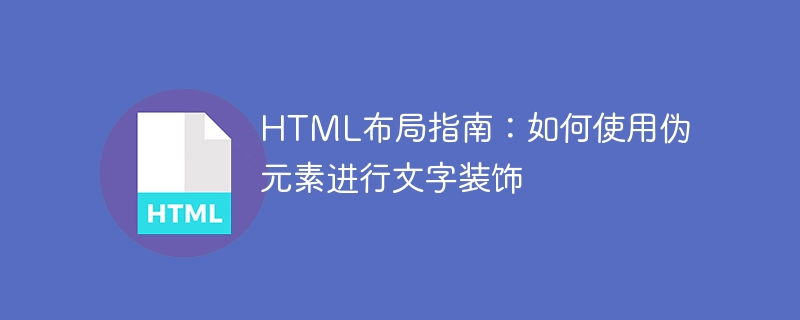

HTML Layout Guide: How to Use Pseudo Elements for Text Decoration
Introduction:
In web design, text decoration is a common way, which can Increase the visual appeal and artistry of your page. In addition to using images for text decoration, we can also use CSS pseudo elements to achieve text effects. This article will delve into how to use pseudo-elements for text decoration and provide specific code examples to help you achieve stunning effects in your HTML layout.
1. What is a pseudo element?
In CSS, a pseudo element is a mechanism used to select a specific part of an element and add styles to it. By using pseudo-elements, we can create and insert virtual elements into the document to achieve special effects. Pseudo elements are represented by double colons "::".
2. How to use pseudo elements
Commonly used pseudo elements include before and after. They create a pseudo-element in the front and back of the selected element respectively. We can use these pseudo-elements for text decoration.
<style>
.paragraph::before {
content: "•";
color: red;
margin-right: 5px;
font-size: 20px;
}
</style>
<p class="paragraph">这是一个段落</p>In the above code, we use the ::before pseudo-element to insert a decorative dot before the paragraph. The content attribute specifies the inserted content, the color attribute sets the color of the dots, the margin-right attribute is used to control the distance between the dots and the text, and the font-size attribute is used to set the size of the dots.
<style>
.paragraph::after {
content: "→";
color: blue;
margin-left: 5px;
font-size: 20px;
}
</style>
<p class="paragraph">这是一个段落</p>In the above code, we use the ::after pseudo-element to insert a decorative arrow after the paragraph. Similar to the before pseudo-element, we can customize the content, color, spacing, and size of the arrow by setting the content, color, margin-left, and font-size attributes.
3. Use pseudo elements for more text decoration effects
In addition to the dot and arrow effects in the above examples, we can also use pseudo elements to achieve various other text decoration effects. Here are some common examples:
Add underline
<style>
.underline::after {
content: '';
display: block;
width: 100%;
border-bottom: 1px solid black;
margin-top: 3px;
}
</style>
<p class="underline">这里有下划线</p>Add border
<style>
.border::after {
content: '';
display: block;
width: 100%;
border: 1px solid black;
margin-top: 5px;
padding: 5px;
}
</style>
<p class="border">这里有边框</p>Add Background color
<style>
.background::after {
content: '';
display: block;
width: 100%;
background-color: lightgray;
margin-top: 5px;
padding: 5px;
}
</style>
<p class="background">这里有背景颜色</p>By using different attributes and styles of pseudo elements, we can achieve various text decoration effects. Just copy the above code to the appropriate location in the HTML document and customize the style to easily achieve the text decoration effect you want.
Conclusion:
Using pseudo-elements for text decoration is a simple and powerful technique that can achieve various cool effects in HTML layout. This article provides specific code examples to help you learn how to use pseudo-elements to decorate text. Whether it is effects such as dots, arrows, underlines, borders, or background colors, they can all be achieved by properly setting the attributes and styles of pseudo elements. I hope this article has helped you use pseudo elements for text decoration and make your web design more outstanding.
The above is the detailed content of HTML Layout Guide: How to Use Pseudo-Elements for Text Decoration. For more information, please follow other related articles on the PHP Chinese website!




